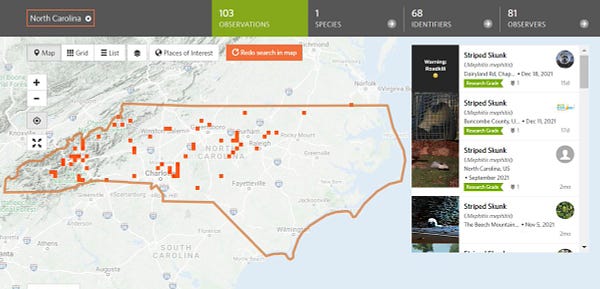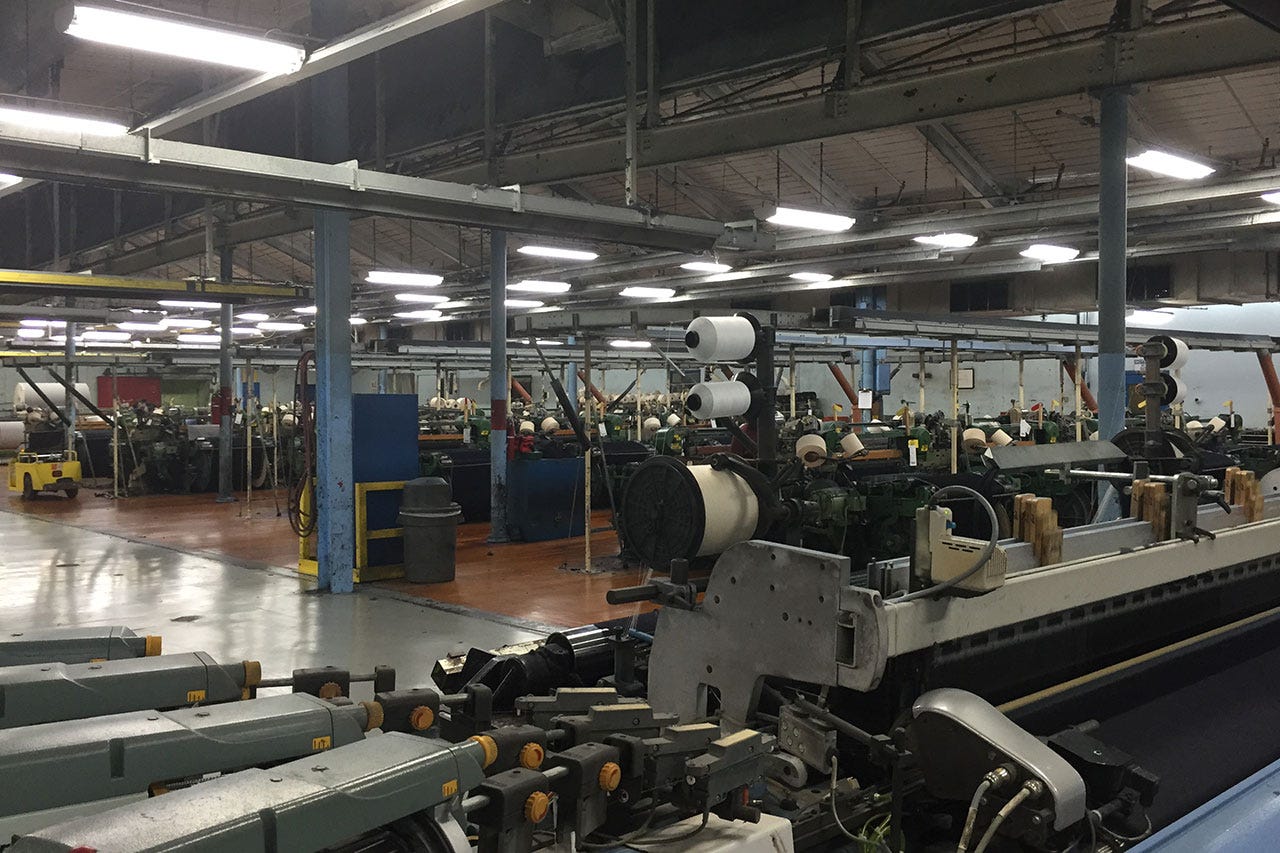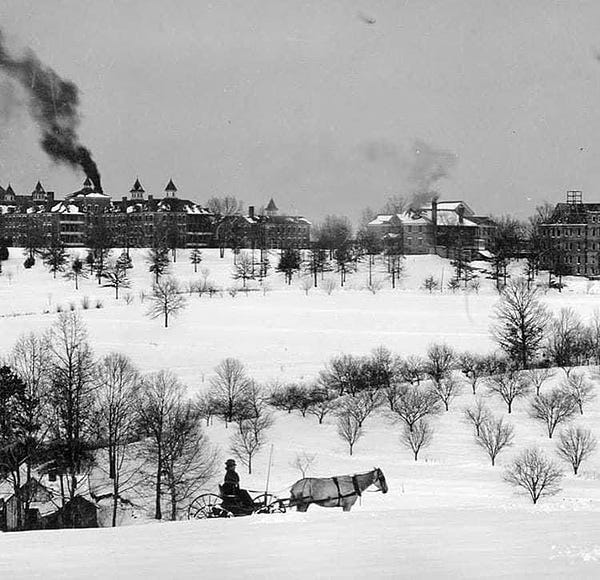The Mystery of the Missing Looms
In Greensboro, rare machines were left behind after a vintage denim factory closed down. What happened to them? Plus: Unitards, red light cameras, and skunks (!) in today's Tiny Rabbit Holes.
Thanks for reading the North Carolina Rabbit Hole! We’re now a reader-supported newsletter, and if you like what you’ve been reading here, please pledge your support with a monthly or yearly subscription. You can help out by clicking or tapping the button below.
A Looming Mystery, Solved
Back in 2015, I got a tour of Cone Denim’s White Oak plant in Greensboro, the last plant in North America that was still making selvage denim. What is selvage? As I wrote in a story for Our State, it’s really strong stuff, special stuff:
The cheapest jeans use something called open fray denim, which comes in 15-foot-wide sheets that are cut at the edges and then sewed back on themselves to keep the whole thing from unraveling. See for yourself: Turn your jeans inside out and check whether the seams are frayed on the inside. Only about $2 worth of fabric constitutes a pair of Wranglers.
But selvage, the denim that’s made at Cone Mills, is shot back and forth across a loom, hitting one edge and then turning back and going to the other side. A piece of fabric is actually one long piece of cotton, going back, forth, and back again — over and over. It’s stronger, and it’s exponentially more expensive. It takes close to $36 worth of selvage to make a pair of Left Field jeans. Wranglers cost about $20 in a store. Left Field? $220.
Back in the day, selvage denim was the type of denim that went into practically all jeans, which had to be tough, since they were once largely worn on the job by blue collar workers. But over time, low price replaced high quality, and jeans manufacturing moved almost exclusively overseas. The White Oak plant, which opened in 1905, was for a time the lone survivor for American selvage, made on 51 hulking, vibrating, vintage Draper X3 looms from the 1940s. The machines were among the last of their kind in the world.
And then, in November 2017, White Oak closed. So, what happened to those looms?
A beautiful new story in Craftsmanship Quarterly unpacked that mystery. Shortly after International Textile Group shut down White Oak, the rumors started. Some people heard that Japanese or Turkish companies had bought them all up. Others thought they might have been sunk into the ocean to make artificial reefs. But nope! They just sat there, much to the shock of the folks who were starting up Vidalia Mills in Louisiana:
It turned out that the man who bought the White Oak plant—Will Dellinger, CEO of JW Demolition, which specializes in mill decommissions—couldn’t bring himself to scrap the old relics. So his demolition team just covered the looms with plastic and let them sit, hoping someone who understood their value would come along and offer Dellinger a fair price. Which Vidalia Mills promptly did. Within weeks, 46 of White Oak’s 51 Draper X3s had been shipped to Louisiana, along with a substantial supply of spare parts and repair manuals. To preserve every trick and quirk of Cone’s old weaving operation, Vidalia even imported White Oak’s wooden floor (a finishing touch its weavers didn’t ultimately need, because they found that placing rubber footings under the looms preserved their quirky shudders and shakes just fine).
Several North Carolina craftspeople who knew how to operate those looms moved to Louisiana as well. And, in September 2019, those old machines were turned back on in their new home. The workers on hand erupted into cheers.
h/t Tom Hanchett
Not All Vintage Things Are Good
I was recently exposed to… these, which made their debut on January 7, 1989:
Stay to the end for a quick Jim Valvano cameo, which he deserves, because this was his idea. The legendary Wolfpack coach was complaining that players jerseys were always coming untucked. Luckily, Nike had a solution for him: THE UNITARD! “It's made out of a material that's incredibly light -- when our kids put 'em on they feel almost naked,” Stupid Sexy Flanders Valvano said at the time.
Which, as you might notice from the video above, they were fairly close to naked. So, the players had to wear shorts, which looked… weird.
Anyhow, this whole experiment only lasted for a short time in 1989, because Valvano said players didn’t think the unitards were comfortable. Right.
On Speed Traps
Last week’s newsletter about the constitutional reason why North Carolina doesn’t have any speed trap towns led a lot of you to recall something else: red light cameras. If you missed it, North Carolina doesn’t have any towns that send out police to prey upon speeding drivers to make their budgets because… they can’t. The state constitution says the “clear proceeds” from all criminal fines and forfeitures have to go back to the county school district. That, also, was what doomed an experiment with another form of traffic enforcement. From reader Jon Cochrane:
As others may reply, in Charlotte some years ago the city installed red light cameras. The camera captured the license plate of cars traveling through an intersection as or after the light turned red. Photo evidence was mailed to the registered owner of the vehicle and a fine was assessed. There was no discretion. As I recall, about half of the money received went to the company that installed and maintained the cameras. A year or so after the program began there was a legal finding that this was against the "all proceeds must go to the schools" statute. The city resisted but the decision was upheld as precedence was longstanding. Therefor we have never had automatic traffic law enforcement since that time.
Yep. There’s also evidence that red light cameras don’t really help, safety wise. Some studies have shown that at intersections with them, T-bone accidents have gone down, but rear-end accidents have gone up.
Also, it’s not just the fines that’ll get ya. It’s the fees.

Doesn’t Pass The Smell Test


Are they… hanging out with the armadillos?
A few last things
I was up REALLY late finishing this newsletter while watching the greatest NFL Prisoner’s Dilemma I’ve ever seen.
About 2,000 people in Rocky Mount are going to lose their jobs because of a fire at a QVC warehouse.
An important story from the News & Observer’s Laura Brache about what museums and researchers should do with the remains of Black and indigenous people that were collected unethically.
Until now, I thought the greatest rap song about Charlotte was “Reverse Angle Parking.” But as former U.S. Secretary of Transportation Anthony Foxx pointed out last week, someone created a rap song about him when he was Charlotte’s mayor. Folks, we got ourselves a good old LOCAL GOVERNMENT RAP BATTLE.
Your Instagram posts of snow on your patio furniture from last week pale in comparison to this:
Have a good week everybody.







